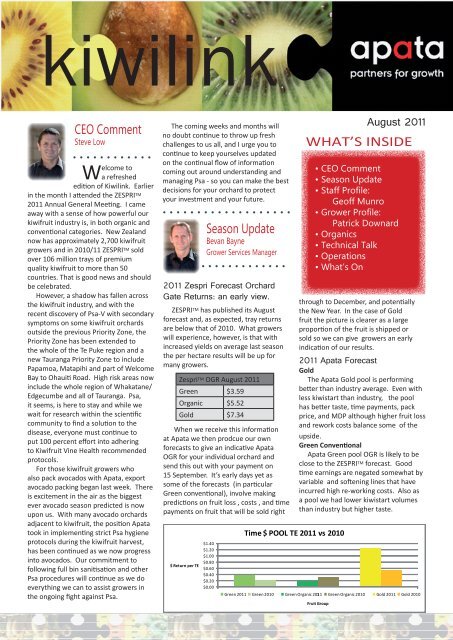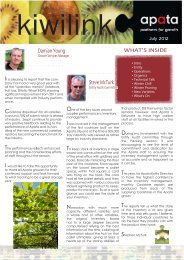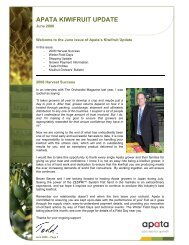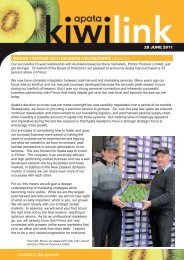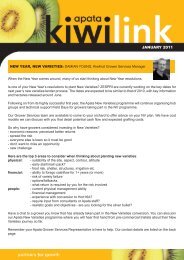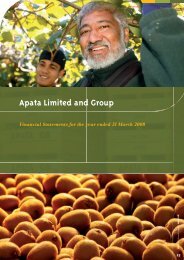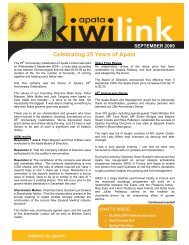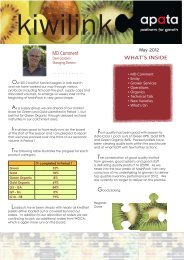Kiwilink - Apata
Kiwilink - Apata
Kiwilink - Apata
You also want an ePaper? Increase the reach of your titles
YUMPU automatically turns print PDFs into web optimized ePapers that Google loves.
kiwilink<br />
CEO Comment<br />
Steve Low<br />
Welcome to<br />
a refreshed<br />
edition of <strong>Kiwilink</strong>. Earlier<br />
in the month I attended the ZESPRItM 2011 Annual General Meeting. I came<br />
away with a sense of how powerful our<br />
kiwifruit industry is, in both organic and<br />
conventional categories. New Zealand<br />
now has approximately 2,700 kiwifruit<br />
growers and in 2010/11 ZESPRItM sold<br />
over 106 million trays of premium<br />
quality kiwifruit to more than 50<br />
countries. That is good news and should<br />
be celebrated.<br />
However, a shadow has fallen across<br />
the kiwifruit industry, and with the<br />
recent discovery of Psa-V with secondary<br />
symptoms on some kiwifruit orchards<br />
outside the previous Priority Zone, the<br />
Priority Zone has been extended to<br />
the whole of the Te Puke region and a<br />
new Tauranga Priority Zone to include<br />
Papamoa, Matapihi and part of Welcome<br />
Bay to Ohauiti Road. High risk areas now<br />
include the whole region of Whakatane/<br />
Edgecumbe and all of Tauranga. Psa,<br />
it seems, is here to stay and while we<br />
wait for research within the scientific<br />
community to find a solution to the<br />
disease, everyone must continue to<br />
put 100 percent effort into adhering<br />
to Kiwifruit Vine Health recommended<br />
protocols.<br />
For those kiwifruit growers who<br />
also pack avocados with <strong>Apata</strong>, export<br />
avocado packing began last week. There<br />
is excitement in the air as the biggest<br />
ever avocado season predicted is now<br />
upon us. With many avocado orchards<br />
adjacent to kiwifruit, the position <strong>Apata</strong><br />
took in implementing strict Psa hygiene<br />
protocols during the kiwifruit harvest,<br />
has been continued as we now progress<br />
into avocados. Our commitment to<br />
following full bin sanitisation and other<br />
Psa procedures will continue as we do<br />
everything we can to assist growers in<br />
the ongoing fight against Psa.<br />
The coming weeks and months will<br />
no doubt continue to throw up fresh<br />
challenges to us all, and I urge you to<br />
continue to keep yourselves updated<br />
on the continual flow of information<br />
coming out around understanding and<br />
managing Psa - so you can make the best<br />
decisions for your orchard to protect<br />
your investment and your future.<br />
Season Update<br />
Bevan Bayne<br />
Grower Services Manager<br />
2011 Zespri Forecast Orchard<br />
Gate Returns: an early view.<br />
ZESPRI tM has published its August<br />
forecast and, as expected, tray returns<br />
are below that of 2010. What growers<br />
will experience, however, is that with<br />
increased yields on average last season<br />
the per hectare results will be up for<br />
many growers.<br />
Zespri tM OGR August 2011<br />
Green $3.59<br />
Organic $5.52<br />
Gold $7.34<br />
When we receive this information<br />
at <strong>Apata</strong> we then prodcue our own<br />
forecasts to give an indicative <strong>Apata</strong><br />
OGR for your individual orchard and<br />
send this out with your payment on<br />
15 September. It’s early days yet as<br />
some of the forecasts (in particular<br />
Green conventional), involve making<br />
predictions on fruit loss , costs , and time<br />
payments on fruit that will be sold right<br />
$ Return per TE<br />
$1.40<br />
$1.20<br />
$1.00<br />
$0.80<br />
$0.60<br />
$0.40<br />
$0.20<br />
$0.00<br />
Time $ POOL TE 2011 vs 2010<br />
August 2011<br />
What’s inside<br />
• CEO Comment<br />
• Season Update<br />
• Staff Profile:<br />
Geoff Munro<br />
• Grower Profile:<br />
Patrick Downard<br />
• Organics<br />
• Technical Talk<br />
• Operations<br />
• What’s On<br />
through to December, and potentially<br />
the New Year. In the case of Gold<br />
fruit the picture is clearer as a large<br />
proportion of the fruit is shipped or<br />
sold so we can give growers an early<br />
indication of our results.<br />
Gold<br />
The <strong>Apata</strong> Gold pool is performing<br />
better than industry average. Even with<br />
less kiwistart than industry, the pool<br />
has better taste, time payments, pack<br />
price, and MDP although higher fruit loss<br />
and rework costs balance some of the<br />
upside.<br />
Green Conventional<br />
<strong>Apata</strong> Green pool OGR is likely to be<br />
close to the ZESPRItM 2011 <strong>Apata</strong> Forecast<br />
forecast. Good<br />
time earnings are negated somewhat by<br />
variable and softening lines that have<br />
incurred high re-working costs. Also as<br />
a pool we had lower kiwistart volumes<br />
than industry but higher taste.<br />
Green 2011 Green 2010 Green Organic 2011 1 Green Organic 2010 Gold 2011 Gold 2010<br />
Fruit Group
Green ORGANIC<br />
Not surprisingly with over half the<br />
industry organic fruit packing at <strong>Apata</strong><br />
we pretty much set the average. Our<br />
forecast suggests the organic pool<br />
will be similar to the ZESPRI forecast<br />
even though we have considerably less<br />
Kiwistart. Good time payments are<br />
being achieved and we look forward to<br />
updating organic growers as more fruit is<br />
shipped.<br />
Once again thank you for your support<br />
and we look forward to bringing you your<br />
individual OGR’s next month.<br />
Staff Profile<br />
Geoff Munro<br />
Organic Coolstore<br />
Manager<br />
G eoff Munro is the Coolstore<br />
Manager at <strong>Apata</strong> Pyes Pa<br />
Organics and has been there for a<br />
whopping 28 years straight.<br />
He was introduced to the kiwifruit<br />
industry through a government-funded<br />
job scheme that was big news in the<br />
Bay of Plenty during the 1980s. Geoff<br />
accepted a cadetship as a young man<br />
and was soon invited to join as a<br />
permanent staff member.<br />
The Pyes Pa site is where Geoff<br />
spends a lot of his time: “I’ve enjoyed<br />
being part of the kiwifruit industry<br />
and what I like most is the indepth<br />
knowledge and experience I’ve obtained,<br />
some of the people I’ve had the<br />
opportunity to work alongside, as well as<br />
being allowed to do the job right.”<br />
In fact, Geoff helped plant the<br />
original kiwifruit orchards we see today:<br />
“I’ve been there since the beginning...<br />
I planted the vines, learned how to<br />
graft them, and so much more. I also<br />
had to pull some of them out when<br />
areas were sold off over the years<br />
for urban development.” He says he<br />
was around when the owners saw a<br />
future in organics - there were trials<br />
with scientists and a huge amount of<br />
foresight. “I’ve been impressed by the<br />
innovation shown and how Pyes Pa has<br />
pioneered organics and now boasts the<br />
most successful organics category in NZ.<br />
Off orchard Geoff manages his own<br />
1.2ha conventional kiwifruit orchard,<br />
Lotus Creek, in Welcome Bay. “I<br />
purchased Lotus Creek about six years<br />
ago. So when I leave work at the end of<br />
the day, I go straight home and continue<br />
working there.”<br />
However, life can’t be too bad...<br />
because Geoff and his wife Lynda,<br />
(<strong>Apata</strong> Pyes Pa Production Manager)<br />
look out from their home upon the<br />
beautiful Kaiaiti Stream every day.<br />
Finally, they share three children<br />
between them – Jake, Katelyn, and<br />
Chantelle – two grandchildren – Kahn<br />
and Melody – and have a Border Collie/<br />
Blue Heeler cross called Jazz. If Geoff<br />
had the spare time he’d re-ignite one<br />
of his favourite pastimes, pig hunting<br />
and deer hunting; he’s been all over<br />
the north island. The closest thing to<br />
recreation, he says, is going fishing for<br />
snapper during the Christmas holidays,<br />
which he absolutely loves.<br />
LtoR: Andrew Wood, Lynda<br />
and Geoff Munro, Pyes Pa<br />
Road site<br />
Joyce Road orchard where Geoff helped<br />
plant these vines in the 1980s<br />
Inside the Pyes Pa Packhouse<br />
Staff packing organic kiwifruit at Joyce Road<br />
packhouse
Grower Profile<br />
Patrick Downard<br />
Waikato Organic<br />
Kiwifruit<br />
in this edition we meet an <strong>Apata</strong><br />
organic kiwifruit grower from the<br />
Waikato. <strong>Apata</strong> CEO Steve Low and<br />
Organic Manager, Andrew Wood, spent<br />
a morning with Patrick Downard and his<br />
family, sitting under the warm winter<br />
sun and talking “everything organics”.<br />
Patrick was born and bred in the<br />
region and, at the age of 33, is one of<br />
the youngest growers in the industry.<br />
His orchard, OraKiwi is nearby the small<br />
farming town of Te Awamutu but he also<br />
manages a diverse horticultural business<br />
called PD Organics Limited, which<br />
includes orchard management, pruning<br />
and spraying for growers in the Waikato.<br />
Currently, Patrick manages a team<br />
of 14 staff: “We are responsible for 10<br />
orchards that span 30 hectares. This is<br />
a huge area that goes from Hamilton to<br />
Otorohanga. We always employ eight<br />
full time staff but in our peak season<br />
staff numbers increase to around 20,<br />
but it’s always a challenge at harvest<br />
because we’re talking about covering a<br />
100km area and it can be hard to attract<br />
and retain good staff,” he says.<br />
Patrick’s dad was in the organic<br />
kiwifruit business for almost 25 years,<br />
so Patrick learned from a young age<br />
what being a grower was all about. But<br />
upon leaving school Patrick didn’t go<br />
straight to work with his dad. He had<br />
held a couple of jobs, but one day his<br />
dad told Patrick he was short on a driver<br />
and asked if he could help out. Patrick<br />
stepped up to help out that day 14 years<br />
ago and has never looked back. “Like<br />
many growers, I learned everything from<br />
the ground up. I started on contract<br />
rates and worked up to being paid a<br />
salary. But it wasn’t until last season<br />
that I took over the family business from<br />
dad when he got a tutoring position,”<br />
says Patrick.<br />
Over the years his passion for organic<br />
kiwifruit went from strength to strength<br />
and he began to dream of owning his<br />
own orchard.<br />
“Seven years ago I started to look for<br />
opportunities to lease and discovered 1<br />
hectare at Pirongia. I ran that orchard<br />
for two seasons. But, when a lease-toown<br />
orchard came up I grabbed it, and<br />
have enjoyed five crops since.”<br />
Patrick’s philosophy about being an<br />
organic kiwifruit grower is that he wants<br />
to leave his land in better shape than<br />
he found it. “My dad has influenced my<br />
view on being in the organic kiwifruit<br />
industry but when my wife, Rachel,<br />
and I had our children we realised even<br />
more how important it is to having a<br />
chemical-poisonous free orchard for<br />
their sake.” He has a vision for Waikato<br />
orchards – to grow consistently good<br />
crops and grow 8,000-plus per hectare<br />
across all growers. He also says he can<br />
grow organic kiwifruit that is equal to<br />
conventional kiwifruit, and is just as<br />
sustainable – this is in the face of the Psa<br />
threat.<br />
As a member of Waikato Kiwifruit<br />
Vine Health (KVH), Patrick is all too<br />
aware of the possibility of Psa disease<br />
spreading to the region.<br />
“No-one can be sure that Psa is not<br />
in the Waikato region already. However,<br />
I strictly adhere to KVH quarantine<br />
protocols at all orchards, but I still think<br />
Waikato growers and kiwifruit industry<br />
people are too blasé and need to tighten<br />
up their thinking and practices. There<br />
is no need for the Waikato to source<br />
anything from the Bay of Plenty and<br />
it concerns me when I hear about<br />
people collecting compost from the Bay<br />
and bringing it into our region. While<br />
spreading Psa in this manner is low risk,<br />
there are compost places available in the<br />
Waikato so why jeopardise our Psa-free<br />
borders?<br />
Patrick’s concern for the spread<br />
of Psa is justified when Waikato<br />
researchers visit the Bay and take their<br />
testing equipment with them, only to<br />
return to the Waikato bringing that same<br />
equipment back with them.<br />
“Waikato people need to get more<br />
serious about preventing Psa. If it If<br />
it means having two sets of pruning<br />
equipment so you can leave a set in the<br />
Bay and have a set in the Waikato, then<br />
this should be done. That way there<br />
is no chance of spreading Psa through<br />
equipment,” says Patrick.<br />
LtoR: Steve Low, Ellice, Luke and Patrick Downard at the Downard orchard property of “OraK
WHY IS MONITORING MY ORCHARD<br />
IMPORTANT?<br />
• Rapid response to Psa infection<br />
reduces the risk of spread and<br />
potential vine dieback.<br />
• Orchardists are strongly encour<br />
aged to monitor regularly and<br />
report their findings by email to<br />
the ZESPRI Grower Contact<br />
Centre.<br />
• Leaf spotting can be caused by<br />
other organisms. Lab testing is<br />
required to positively identify<br />
Psa.<br />
• Identifying changes in the level or<br />
degree of symptoms is important.<br />
WHO SHOULD DO IT?<br />
Orchardists are responsible for<br />
ensuring their orchard is monitored<br />
for Psa. APATA can help you with how<br />
to monitor, what to monitor for, and<br />
may also be able to provide resources<br />
to monitor your orchard similar to Pest<br />
monitoring Services provided in summer.<br />
(dependent on location and frequency<br />
required.) This would be a user pays<br />
service.<br />
HOW OFTEN SHOULD I MONITOR?<br />
• Monitoring frequency and<br />
intensity are dependent on<br />
orchard Psa status, location,<br />
variety and time of the year.<br />
• Orchardists should monitor<br />
fortnightly if outside of PZ, or<br />
weekly if within PZ.<br />
• Monitor an orchard by walking<br />
every third row scanning<br />
the canopy for any signs of Psa<br />
symptoms.<br />
• Walk a different set of rows for<br />
each monitoring round (over the<br />
course of 4-6 weeks all rows in<br />
the orchard should be checked<br />
for Psa symptoms.<br />
• Orchardists should remain alert<br />
for signs of Psa at any time<br />
especially during or after cooler,<br />
wetter weather and any<br />
significant climatic events that<br />
give rise to plant injury e.g. wind<br />
storm or hail event.<br />
know your enemy!<br />
WHAT ELSE SHOULD I LOOK FOR?<br />
• Focus on areas of stress in the<br />
orchard e.g. frost pockets, wet<br />
areas, wind damaged areas or areas<br />
that have previously recorded leaf<br />
spot.<br />
• Look for red and clear exudates.<br />
• In some cases it may appear as a<br />
dark colour orange staining (rust)<br />
from where weeping was occurring<br />
and has since dried.<br />
• Cankers may also be beginning to<br />
form in correlation with exudates.<br />
Look for cane dieback where canes<br />
appear dry and dead even though<br />
they are still attached to the parent<br />
vine.<br />
• Mark vines with symptoms with a<br />
coloured tape. Date the tapes and<br />
record the symptoms.<br />
- Establish the level of symptoms in<br />
the immediate vicinity by<br />
monitoring the rest of the block,<br />
walking every row.<br />
- Take a close up digital photo of the<br />
symptoms (or representative<br />
photos if there are a number of<br />
similar symptoms.)<br />
• If any symptoms are seen, confirm<br />
that the symptoms are typical of Psa<br />
by referencing the KVH Winter<br />
symptons Pictorial on the KVH<br />
website<br />
REPORTING OF SYMPTOMS<br />
• Enter monitoring details on the<br />
Symptom Monitoring Sheet (available<br />
from www.kvh.org.nz)<br />
• Ensure the correct contact details<br />
are entered on the monitoring<br />
sheet. (i.e. the person who is going to<br />
accompany the sampler.)<br />
• Email this sheet, along with any<br />
photos taken, to contactcanopy@<br />
zespri.com. It is important to<br />
report both when symptoms have<br />
been observed, and when monitoring<br />
has identified no symptoms.<br />
• Staff will review the photos and<br />
decide if a laboratory test is required.<br />
• You will be advised if a sample is<br />
required from your orchard - or if the<br />
photos do not appear to be Psa.<br />
SAMPLING<br />
• If a sample is required KVH will<br />
arrange for an independent sampler<br />
to visit your property and collect this<br />
sample and you should be advised of<br />
the results of the test within five<br />
days.
Andrew Wood<br />
<strong>Apata</strong> Pyes Pa<br />
Organics Manager<br />
the Pyes Pa site staff are working<br />
diligently condition checking and<br />
repacking the organic crop to meet the<br />
current shipping orders. As at August<br />
21 the volume of HWOB fruit loaded<br />
out was 73% of submitted totals with a<br />
current fruit loss figure of 1.6%. Both the<br />
Pyes Pa and Joyce Road facilities are still<br />
operational with repack teams working<br />
long hours at both sites.<br />
The GKOB crop is currently 98%<br />
loaded out with final orders imminent<br />
which will clear the coolstores of<br />
remaining product. Fruit loss for the<br />
GKOB category is currently 1.62% of<br />
submit which is a solid result. Once again<br />
the ZESPRItM Market Report indicates a<br />
strong sales programme with excellent<br />
demand for organic gold product<br />
reported in the market place.<br />
ZESPRItM also reports satisfactory<br />
sales of the organic green crop with<br />
substantial improvements in sale<br />
volumes in Japan and encouraging<br />
results in the Europe programme. While<br />
large count sizes are fully allocated<br />
movement offshore has been slow, but<br />
ZESPRItM indicates that this situation is<br />
being monitored closely.<br />
Out on the orchards, winter pruning<br />
is progressing well with Psa protocols<br />
and the associated management<br />
practices to the fore on most orchards.<br />
Soil tests and nutrient applications<br />
should now be underway to ensure<br />
orchards are adequately positioned to<br />
maximise the upcoming crop. BioGro<br />
auditing is approaching and application<br />
paperwork should be renewed to ensure<br />
organic status is maintained.<br />
Technical Talk<br />
Wade Hunkin<br />
<strong>Apata</strong> Technical Advisor<br />
as we move into spring the<br />
enormity of the problem Psa is<br />
creating is being brought home to us<br />
all with a thump. Sadly, it is probable<br />
the find in Matapihi and subsequent<br />
establishment of high risk zones to<br />
include the whole of the Bay of Plenty<br />
is just the start of finds outside of Te<br />
Puke. Within Te Puke, finds are being<br />
made in more and more gold orchards<br />
and we expect to see signs in Hayward<br />
orchards as budbreak approaches.<br />
However, as we understand the<br />
situation better we also appreciate<br />
that the way forward is to prevent<br />
infection in the first place. To do that<br />
we need the right products but as<br />
importantly we need to achieve 100<br />
percent coverage of the plant. In<br />
addition, we will need to minimise, or<br />
even better, eliminate open wounds<br />
within the summer canopy.<br />
Winter Pruning<br />
The start point of your summer<br />
canopy is the winter pruning job.<br />
The key to getting penetration and<br />
minimising summer work is to get the<br />
wood selection and bud spacing right<br />
now.<br />
If your winter work is not yet<br />
complete reexamine your targets and<br />
instructions you are giving to whoever<br />
will be doing/managing the work.<br />
Look to increase the spacing and<br />
select quieter wood; that may mean<br />
fewer flowers but experience suggests<br />
fewer flowers translates into better<br />
flowers, so the final trays packed are<br />
not significantly compromised. Less<br />
summer work means more to spend<br />
on protective sprays. Even if the<br />
winter job is complete it will be worth<br />
spending money to reduce the bud<br />
spacing and remove wood that will<br />
produce more vigorous growth.<br />
Spring Protective Programme<br />
KVH have released a comprehensive<br />
set of recommendations for the spring<br />
period that covers monitoring as well as<br />
a protective spray programme http://<br />
www.kvh.org.nz/springmanagement.<br />
Growers are the best placed to<br />
monitor their own orchard but <strong>Apata</strong><br />
is able to provide assistance if it is<br />
required.<br />
Conventional Spray programme<br />
The spray programme is based upon<br />
a continuation of the use of copper,<br />
and for those in a High Risk area or<br />
Priority Zone the option is to use the<br />
antibiotic Streptomycin in the form<br />
of KeyStrepto. Use of Streptomycin<br />
is limited to three applications<br />
preflowering. It is a short-lived, although<br />
effective sterilant, so it needs to be<br />
targeted to times of greatest risk.<br />
Streptomycin is not a silver bullet and<br />
needs to be used with care as one<br />
part of an integrated programme of<br />
protective products and monitoring.<br />
Use of KeyStrepto is currently on<br />
hold while a robust set of protocols<br />
around its use are established. Ensure<br />
you understand the full requirements.<br />
A standard conventional programme<br />
for both Hort16A and Hayward over the<br />
period from now until flowering should<br />
comprise timed applications of copper<br />
products with the optional addition of a<br />
sterilant such as Sporekill.<br />
Water rates and product<br />
concentration will depend on the spray<br />
technology being used and the degree<br />
of canopy development (refer to Table<br />
1 overpage). In general, after budbreak<br />
use the label rate for concentration and<br />
match water rate per ha to the amount<br />
of canopy. There is a full paper available<br />
on the KVH website. Use KeyStrepto in<br />
the lead up to significant rain (48 hours<br />
of wet leaves) or frost events post<br />
budbreak, that may cause<br />
physical damage<br />
to the leaves,<br />
but do not use<br />
within a week<br />
of the first male<br />
flowers opening.<br />
Post flowering we<br />
expect to see a wider<br />
range of biological and<br />
elicitors becoming part<br />
of the mix.


